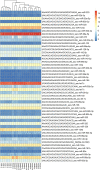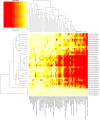MicroRNA profiling of the pig periaqueductal grey (PAG) region reveals candidates potentially related to sex-dependent differences
- PMID: 33451362
- PMCID: PMC7809845
- DOI: 10.1186/s13293-020-00343-2
MicroRNA profiling of the pig periaqueductal grey (PAG) region reveals candidates potentially related to sex-dependent differences
Abstract
Background: MicroRNAs indirectly orchestrate myriads of essential biological processes. A wide diversity of miRNAs of the neurodevelopmental importance characterizes the brain tissue, which, however, exhibits region-specific miRNA profile differences. One of the most conservative regions of the brain is periaqueductal grey (PAG) playing vital roles in significant functions of this organ, also those observed to be sex-influenced. The domestic pig is an important livestock species but is also believed to be an excellent human model. This is of particular importance for neurological research because of the similarity of pig and human brains as well as difficult access to human samples. However, the pig PAG profile has not been characterized so far. Moreover, molecular bases of sex differences connected with brain functioning, including miRNA expression profiles, have not been fully deciphered yet.
Methods: Thus, in this study, we applied next-generation sequencing to characterize pig PAG expressed microRNAs. Furthermore, we performed differential expression analysis between females and males to identify changes of the miRNA profile and reveal candidates underlying sex-related differences.
Results: As a result, known brain-enriched, and new miRNAs which will expand the available profile, were identified. The downstream analysis revealed 38 miRNAs being differentially expressed (DE) between female and male samples. Subsequent pathway analysis showed that they enrich processes vital for neuron growth and functioning, such as long-term depression and axon guidance. Among the identified sex-influenced miRNAs were also those associated with the PAG physiology and diseases related to this region.
Conclusions: The obtained results broaden the knowledge on the porcine PAG miRNAome, along with its dynamism reflected in different isomiR signatures. Moreover, they indicate possible mechanisms associated with sex-influenced differences mediated via miRNAs in the PAG functioning. They also provide candidate miRNAs for further research concerning, i.e., sex-related bases of physiological and pathological processes occurring in the nervous system.
Keywords: Brain; NGS; PAG; Pig; microRNAs.
Conflict of interest statement
The authors declare that they have no competing interests.
Figures







Similar articles
-
Sex-biased gene and microRNA expression in the developing mouse brain is associated with neurodevelopmental functions and neurological phenotypes.Biol Sex Differ. 2023 Sep 7;14(1):57. doi: 10.1186/s13293-023-00538-3. Biol Sex Differ. 2023. PMID: 37679839 Free PMC article.
-
Tissue-specific expression and regulatory networks of pig microRNAome.PLoS One. 2014 Apr 3;9(4):e89755. doi: 10.1371/journal.pone.0089755. eCollection 2014. PLoS One. 2014. PMID: 24699212 Free PMC article.
-
MicroRNA transcriptome analysis of porcine vital organ responses to immunosuppressive porcine cytomegalovirus infection.Virol J. 2018 Jan 18;15(1):16. doi: 10.1186/s12985-018-0922-x. Virol J. 2018. PMID: 29347945 Free PMC article.
-
[Advances in porcine miRNAome].Yi Chuan. 2014 Oct;36(10):974-84. doi: 10.3724/SP.J.1005.2014.0974. Yi Chuan. 2014. PMID: 25406245 Review. Chinese.
-
An emerging role for microRNAs in sexually dimorphic neurobiological systems.Pflugers Arch. 2013 May;465(5):655-67. doi: 10.1007/s00424-013-1227-y. Epub 2013 Feb 9. Pflugers Arch. 2013. PMID: 23397171 Free PMC article. Review.
Cited by
-
Benchmarking of bioinformatics tools for NGS-based microRNA profiling with RT-qPCR method.Funct Integr Genomics. 2023 Nov 30;23(4):347. doi: 10.1007/s10142-023-01276-w. Funct Integr Genomics. 2023. PMID: 38030823 Free PMC article.
References
-
- Brambilla G, Cantafora A. Metabolic and cardiovascular disorders in highly inbred lines for intensive pig farming: how animal welfare evaluation could improve the basic knowledge of human obesity. Ann Ist Super Sanita. 2004;40:241–244. - PubMed
-
- Sartor RB. Probiotic therapy of intestinal inflammation and infections. Curr Opin Gastroenterol. 2005;21(1):44–50. - PubMed
Publication types
MeSH terms
Substances
Grants and funding
LinkOut - more resources
Full Text Sources
Molecular Biology Databases
Research Materials

